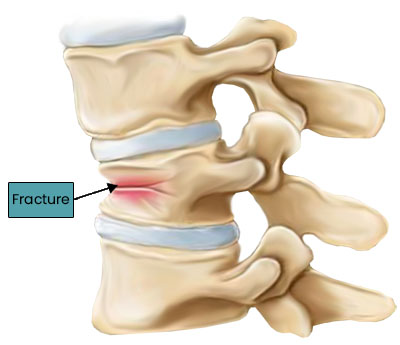What is a Compression Fracture?

A spinal compression fracture occurs when the bony block or vertebral body in the spine collapses. When this happens, it can lead to severe pain, loss of height, and even deformity. Although this type of fracture more commonly occurs in the thoracic spine, it can also occur in the lower back.
Causes of a Compression Fracture
People who experience osteoporosis are more likely to get a compression fracture. They are at higher risk because of their weak and brittle bones. In fact, a simple sneeze or lifting a light object can cause this fracture. Vertebral fractures are actually the most common in patients with osteoporosis. And as you age, this risk increases.
Sometimes, even people with a healthy spine can incur this injury. And it’s actually common for little to no symptoms at all.
Patients younger than 55 who have a spinal compression fracture should be considered for metastatic tumors. These bones are in the right place for a tumor or fracture to occur. As a matter of fact, cancer may cause the destruction of part of the vertebrae until it completely collapses.
Symptoms of the Injury
When experiencing a spinal fracture, symptoms may occur, such as:
- Sudden onset of back pain
- Limited mobility in the spine
- Increase in pain intensity while standing or walking
- Decrease in pain intensity while lying on the back
- Eventual deformity and disability
- Eventual height loss
Treating a Spinal Compression Fracture
Although the conservative method is also first offered, if the fracture is severe enough, surgery might be required. First, we explore options, such as:
Non-Surgical Options
Medications: Over the counter pain medication for pain relief. Both acetaminophen and nonsteroidal anti-inflammatory drugs (NSAIDs) are recommended. Depending on the pain level, muscle relaxants, and medicines for nerve/bone pain are prescribed.
Back Bracing: After a compression fracture, a back brace is typical. This brace provides support similar to a leg fracture, limiting mobility while it heals.
Surgical Options:
Kyphoplasty
Kyphoplasty involves the insertion of a tube with a deflated balloon at its end. It’s then stuck into the fractured vertebra. And the balloon is inflated to restore the height of the collapsed vertebra. Bone cement is injected into the space created by a balloon. This provides the necessary height to be restored to normal.
Vertebroplasty
Vertebroplasty is very similar to kyphoplasty. However, the difference being the absence of a balloon. In vertebroplasty, orthopedic cement or Polymethylmethacrylate (PMMA) is inserted into the collapsed vertebra. And this is performed with a syringe, under fluoroscopic guidance.
Sometimes an open surgery is required. Spinal fusion stabilizes the spine, by utilizing the help of a bone graft, and screws, or rods.
Depending upon the severity of the fracture, and the procedure performed, you may be discharged the same day. On the other hand, there are circumstances where you need to be hospitalized for a few days.
If you suspect you are at risk or had a spinal compression fracture, call us immediately at 888-409-8006. Our Top Orthopedic Surgeon in Boca Raton will be happy to assist you.
